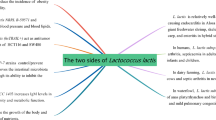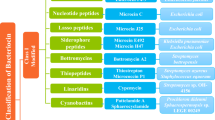Abstract
This study aimed to evaluate lactic acid bacteria isolates from Saanen goats’ milk for probiotic attributes, thereby determining their potential as direct-fed microbials for goats. Isolates were identified using API 50CH system, 16S rDNA sequencing and matrix-assisted laser desorption ionization-time of flight mass spectrometry. All 17 isolates obtained were identified as Lactobacillus plantarum except one identified as Pediococcus acidilactici. Four isolates identified as L. plantarum (Accession numbers KJ026587.1, KM207826.1, KC83663.1 and KJ958428.1) by at least two of the techniques used and isolate 17 differently identified by all the methods used were selected as representatives and then screened for probiotic properties. These isolates displayed phenotypic probiotic attributes including tolerance to acid and bile salts, ability to adhere to intestines and possession of antagonistic activities against Proteus vulgaris, Staphylococcus aureus, Salmonella typhimurium, Pseudomonas aeruginosa and Escherichia coli. The lactic acid bacteria isolated from Saanen goats’ milk showed potential to be used as sustainable probiotics in goats’ industry. Successful use of probiotics in animals depends upon availability of appropriate isolates originating from the specific host animal. This study is a positive contribution towards identification of isolates with potential for formulation as direct-fed microbials for South African Saanen goats.


Similar content being viewed by others
References
Anadon A, Rosa Martinez-Larranaga MP, Martinez MA (2006) Probiotics for animal nutrition in the European Union. Regulation and safety assessment. Regul Toxicol Pharmacol 45:91–95
Awan J, Rahman SU (2005) Microbiology manual. Unitech Communications, Faisalabad, pp. 49–51
Aymerich T, Martin B, Garriga M, Vidal-Carou MC, Bover-Cid S, Hugas M (2006) Safety properties and molecular strain typing of lactic acid bacteria from slightly fermented sausages. J Appl Microbiol 100:40–49
Badis A, Guetarni D, Moussa Boudjema B, Henni DE, Kihal M (2004) Identification and technological properties of lactic acid bacteria isolated from raw goat milk of four Algerian races. Food Microbiol 21:579–588
Bergonier D, Cremoux R, Rupp R (2003) Mastitis in dairy small ruminants. J. Vet Res 34:689–716
Brink M, Todorov SD, Martin JH, Senekal M, Dicks LMT (2006) The effect of prebiotics on production of antimicrobial compounds, resistance to growth at low pH and in the presence of bile, and adhesion of probiotic cells to intestinal mucus. J Appl Microbiol 100:813–820
Boonaert CJP, Rouxhet PG (2000) Surface of lactic acid bacteria: relationships between chemical composition and physicochemical properties. J Appl Environ Microbiol 66:2548–2554
Charteris WP, Kelly PM, Morelli L, Collins JK (1998) Antibiotic susceptibility of potential probiotic Lactobacillus species. J Food Prot 61(12):1636–1643
Charteris WP, Kelly PM, Morelli L, Collins JK (1997) Selective detection, enumeration and identification of potentially probiotic Lactobacillus and Bifidobacterium species in mixed bacterial populations. Int J Food Microbiol 35(1):1–27
Corzo G, Gilliland SE (1999) Measurement of bile salt hydrolase activity from Lactobacillus acidophilus based on disappearance of conjugated of bile salts. J Dairy Sci 82:466–471
D’ Aimmo MR, Modesta M, Biavati B (2007) Antibiotic resistance of lactic acid bacteria and Bifidobacterium sp. isolated from dairy and pharmaceutical products. Int J Food Microbiol 115:35–42
de Almeida Júnior WLG, da Silva FῚ, de Souza JV, da Silva CDA, da Costa MM, Dias FS (2015) Characterization and evaluation of lactic acid bacteria isolated from goat milk. Food Control 53:96–103
Duary RK, Rajput YS, Batish VK, Grover S (2011) Assessing the adhesion of putative indigenous probiotic lactobacilli to human colonic epithelial cells. India. J Med Res 134(5):664–671
Dunne C, O’ Mahony L, Murphy L, Thornton G, Morrissey D (2001) In vitro selection criteria for probiotic bacteria of human origin: correlation with in vitro findings. Am J Clin Nutr 73:386–392
EL-zubeir IEM, Ahmed MI (2007) The hygienic quality of raw milk produced by some dairy farms in Khartoum-Sudan. J Microbiol 2:988–991
Gaggìa F, Mattarelli P, Biavati B (2010) Probiotics and prebiotics in animal feeding for safe food production. Int J Food Microbiol 141:15–28
Gupta PK, Mital BK, Garg SK (1996) Characterization of Lactobacillus acidophilus strains for use as dietary adjunct. Int J Food Microbiol 29:105–109
Hamon E, Horvatovich P, Izquierdo E, Bringel F, Marchionil E (2011) Comparative proteomic analysis of Lactobacillus plantarum for the identification of key proteins in bile tolerance. BMC Microbiol 11:63–69
Harrigan WF, McCance ME (1976) Laboratory methods. In: Harrigan WF, McCance ME (eds) International food dairy microbiology. Academic Press, New York, pp. 12–15
Hemant C, Harshada J (2015) Antagonistic effect of Lactobacillus isolates from cow milk on selected pathogenic bacteria. Res J Recent Sci 4:173–176
Hill C, Guarner F, Reid G, Gibson GR, Merenstein DJ, Pot B, Morelli L, Canani RB, Flint HJ, Salminen S, Calder PC, Sanders ME (2014) Expert consensus document. The international scientific Association for Probiotics and Prebiotics consensus statement on the scope and appropriate use of the term probiotic. Nat Rev Gastroenterol Hepatol 11:506–514
Holland RE (1990) Some infectious causes of diarrhoea in young farm animals. Clin Microbiol Rev 3(4):345–375
Lankaputhra WE, Shah NP (1995) Survival of Lactobacillus acidophilus and Bifidobacterium spp. in the presence of acid and bile salts. Cult Dairy Prod J 30:2–7
Liu Z, Jiang Z, Zhou K, Li P, Liu G, Zhang B (2007) Screening of bifidobacteria with acquired tolerance to human gastrointestinal tract. Anaerobe 13:215–219
Liu C, Zhang Z, Dong K, Yuan J, Guo X (2009) Antibiotic resistance of probiotic strains of lactic acid bacteria isolated from marketed foods and drugs. J Biomedical. Environ Sci 22:401–412
Marroki A, Zuniga M, Kihal M, Perez-Martinez (2011) Characterization of Lactobacillus from Algerian goat’s milk based on phenotypic, 16S rDNA sequencing and their technological properties. Braz J Microbiol 42:158–171
McEwen SA, Fedorka-Cray PJ (2002) Antimicrobial use and resistance in animals. Clin Infect Dis 34(3):93–106
Mohankuman A, Murugalatha N (2011) Characterization and antibacterial activity of bacteriocin producing Lactobacillus isolated from raw cattle milk sample. Int J Biol 3(3):128–143
Muller T (1990) Comparison of methods of differentiation between homofermentative and heterofermentative lactic acid bacteria. Zentralblatt fur Mikrobiologie 15(5):363–366
Nair AS, Dubhashi AV (2016) In-vitro transit tolerance of probiotic Bacillus species in human gastrointestinal tract. IJSR 5(6):1899–1902
Perin LM, Nero LA (2014) Antagonistic lactic acid bacteria isolated from goat milk and identification of a novel nisin variant Lactococcus lactis. BMC Microbiol 14:36
Picon A, Garde S, Ávila M, Nunez M (2016) Microbiota dynamics and lactic acid bacteria biodiversity in raw goat milk cheeses. Int Dairy J 58:14–22
Prasad J, Gill H, Smart J, Gopal PK (1998) Selection and characterization of Lactobacillus and Bifidobacterium strains for use as probiotic. Int Dairy J 8:993–1002
Randazzo CL, Restuccia C, Romano AD, Caggia C (2004) Lactobacillus casei, dominant species in naturally fermented Sicilian green olives. Int J Food Microbiol 90:9–14
Saarela M, Mättö J, Mattila-Sandholm T (2002) Safety aspects of Lactobacillus and Bifidobacterium species originating from human orogastrointestinal tract or from probiotic products. Microb Ecol Health Dis J 14:233–240
Shareef AM, Al-Dabbagh ASA (2009) Effect of probiotic (Saccharomyces cerevisiae) on performance of broiler chicks. Iraqi. J Vet Sci 2(1):23–29
Sharma P, Tomar SK, Goswami P, Sangwan V, Singh R (2014) Antibiotic resistance among commercially available probiotics. Food Res Int 57:176–195
Sharpe ME (1979) Identification of the lactic acid bacteria. In: Skinner FA, Lovelock DW (eds) Identification methods for microbiologists. Academic Press, London, pp. 233–259
South Africa (2001) Regulations relating to milk and dairy products (update), Government Notice No. R489 of 8 June (2001). Department of Health. Government Printer, Pretoria, pp. 1–19
Teheri H, Tabandeh F, Moravej H, Zaghari M, Shivazad M, Shariati P (2009) Potential probiotic of Lactobacillus johnsonii LT171 for chicken nutrition. African J Biotech 8:5833–5837
Tormo H, Lekhal DAH, Roques C (2015) Phenotypic and genotypic characterization of lactic acid bacteria isolated from raw goat milk and effect of farming practices on the dominant species of lactic acid bacteria. Int J Food Microbiol 210:9–15
Tuomola EM, Salminen SJ (1998) Adhesion of some probiotic and dairy Lactobacillus strains to Caco-2 cell cultures. Int J of. Food Microbiol 41:45–51
Verdenilli MC, Ghelf F, Silvi S, Orpianesi C, Cecchini C, Cresci A (2009) Probiotic properties of Lactobacillus rhamnosus and Lactobacillus paracasei isolated from human faeces. Eur. J Nutri 48:355–363
Van der Mei HC, Busscher HJ (2001) Electrophoretic mobility distributions of single strain microbial populations. J Appl Environ Microbiol 67:491–494
Vlková E, Grmanová M, Rada V, Homutavá I, Dubná S (2009) Selection of probiotic bifidobacteria for lambs. Czech. J Animal Sci 54:552–565
Walker D, Gilliland SE (1993) Relationships among bile tolerance, bile salt deconjugation and assimilation of cholesterol by Lactobacillus acidophilus. J Dairy Sci 76:956–961
Acknowledgements
This study was financially supported by the Agricultural Research Council, Irene, South Africa.
Author information
Authors and Affiliations
Corresponding author
Ethics declarations
Conflict of Interest
The authors declare that they have no conflict of interest.
Rights and permissions
About this article
Cite this article
Makete, G., Aiyegoro, O.A. & Thantsha, M.S. Isolation, Identification and Screening of Potential Probiotic Bacteria in Milk from South African Saanen Goats. Probiotics & Antimicro. Prot. 9, 246–254 (2017). https://doi.org/10.1007/s12602-016-9247-5
Published:
Issue Date:
DOI: https://doi.org/10.1007/s12602-016-9247-5




